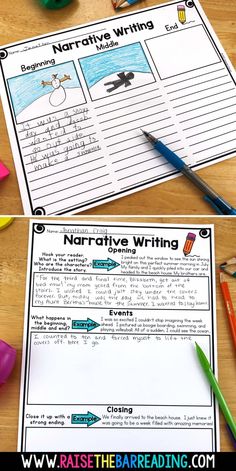Narrative writing plays a crucial role in developing a student’s storytelling abilities, fostering creativity, and enhancing expressive skills. However, teaching narrative writing can sometimes be challenging due to its subjective and artistic nature. Below are 32 strategies and tips for educators to effectively scaffold and nurture narrative writing capabilities in their students.
1.Brainstorm Ideas: Encourage students to brainstorm various topics, events, or personal experiences that could serve as the foundation for their stories.
2.Understand the Structure: Teach the fundamental structure of narrative writing, which typically includes an introduction, rising action, climax, falling action, and resolution.
3.Use Graphic Organizers: Utilize tools such as story maps or Venn diagrams to help students organize their thoughts and sequence events logically.
4.Study Examples: Have students read and discuss exemplary narrative texts so they can model their writing on effective storytelling techniques.
5.Focus on Sensory Details: Help students enrich their narratives by incorporating sensory descriptions that add depth to their settings and characterizations.
6.Practice Descriptive Writing: Regular exercises in descriptive writing can sharpen students’ ability to paint vivid pictures with words.
7.Develop Characters: Encourage the creation of compelling characters by asking students to outline backstories, motivations, and characteristics.
8.Explore Dialogue: Teach how to write realistic dialogue that moves the story forward and reveals character traits.
9.Emphasize Conflict: Discuss the importance of conflict within a story and how it drives the plot and engages readers.
10.Set the Tone: Work with students on establishing the mood or tone of a story, whether it’s humorous, suspenseful, or melancholic.
11.Use Mentor Texts: Provide students with mentor texts that exemplify strong narrative elements for them to analyze and learn from.
12.Peer Review Sessions: Conduct peer review workshops where students give constructive feedback on each other’s work.
13.Rewrite Real Life Events: Suggest rewriting real-life events with fictional twists as a fun way to practice narrative skills.
14.Personal Narratives: Assign personal narrative essays to help students draw from their own lives and experiences.
15.Implement Technology: Integrate digital storytelling tools or writing apps that can make the writing process more engaging.
16.Writing Prompts: Offer creative prompts or story starters to kindle imagination and overcome writer’s block.
17.Focus on Pacing: Teach how pacing affects the flow of a story and how to adjust it for maximum impact.
18.Create Storyboards: Use storyboarding techniques where students illustrate key scenes before writing them out.
19.Encourage Reading Aloud: Have students read their stories aloud either during drafting or upon completion to help refine voice and pacing.
20.Editing Checklists: Provide checklists that cover plot consistency, character development, grammar, punctuation, etc., for self-editing purposes.
21.Variety in Sentence Structure: Discuss the importance of varying sentence structure to make narratives more interesting.
22.Non-linear Storytelling: Introduce concepts like flashbacks or non-chronological order to create complex narratives.
23.Address Point of View: Make sure students understand different points of view (first person, third person) and how each influences storytelling style.
24.Word Choice Matters: Stress the importance of precise language choices in conveying themes and emotions accurately.
25.Incorporate Figurative Language: Teach similes, metaphors, personification, etc., to enhance descriptions.
26.Theme Development: Discuss how a thematic backbone can give direction to narrative stories.
27 Estimate your Timeline Properly
28 Emphasize Revision as an opportunity
29 Consider Digital Narratives over Traditional Narratives
30 Encourage Exploration outside Comfort Zones
31 Set attainable goals
32 Foster





